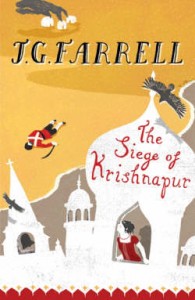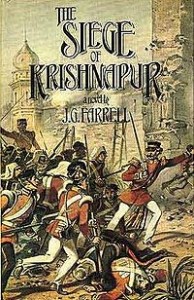Weekend Deviation – The Best of the Booker – The Siege of Krishnapur
Posted: January 16th, 2011 | 1 Comment »I have the recent Best of the Booker promotion to thank for being introduced to JG Farrell’s The Siege of Krishnapur. This tale of an Indian town and its foreign residents during the Indian Mutiny (or the Indian Rebellion depending on how recently you were taught history) was inspired by events at Cawnpore and Lucknow. It’s extremely witty (and the only book I’ve read by the apparently consistently witty Farrell) and won the Booker in 1973. That’s a bit before my time and the book rather sunk from the reading list in the intervening decades (Farrell apparently didn’t endear himself by slagging of the Booker firm when he accepted the award). I liked his style so much I’m looking out Farrell’s The Singapore Grip about the colony in the days before the Japanese invasion. As usual blurb below as well as, first, the current cover and after that the original one:
“The first sign of trouble at Krishnapur came with a mysterious distribution of chapatis, made of coarse flour and about the size and thickness of a biscuit; towards the end of February 1857, they swept the countryside like an epidemic.”
Students of history will recognise 1857 as the year of the Sepoy rebellion in India–an uprising of native soldiers against the British, brought on by Hindu and Muslim recruits’ belief that the rifle cartridges with which they were provided had been greased with pig or cow fat. This seminal event in Anglo-Indian relations provides the backdrop for J.G. Farrell’s Booker Prize- winning exploration of race, culture and class, The Siege of Krishnapur. Like the mysteriously appearing chapatis, life in British India seems, on the surface, innocuous enough. Farrell introduces us gradually to a large cast of characters as he paints a vivid portrait of the Victorians’ daily routines that are accompanied by heat, boredom, class-consciousness and the pursuit of genteel pastimes intended for cooler climates. Even the siege begins slowly, with disquieting news of massacres in cities far away. When Krishnapur itself is finally attacked, the Europeans withdraw inside the grounds of the Residency where very soon conditions begin to deteriorate: food and water run out, disease is rampant, people begin to go a little mad. Soon the very proper British are reduced to eating insects and consorting across class lines. Farrell’s descriptions of life inside the Residency are simultaneously horrifying and blackly humorous. The siege, for example, is conducted under the avid eyes of the local populace, who clearly anticipate an enjoyable massacre and thus arrive every morning laden with picnic lunches (plainly visible to the starving Europeans). By turns witty and compassionate, The Siege of Krishnapur comprises the best of all fictional worlds: unforgettable characters, an epic adventure and at its heart a cultural clash for the ages.


J G Farrell was my favourite writer, having read all of his works I longed for the next but he was swept out to sea while salmon fishing. Do read Troubles.